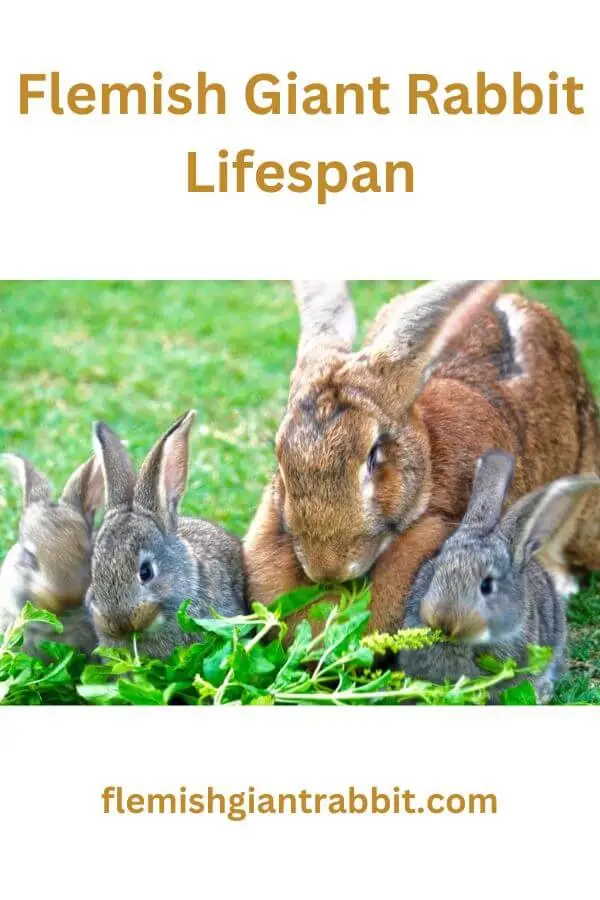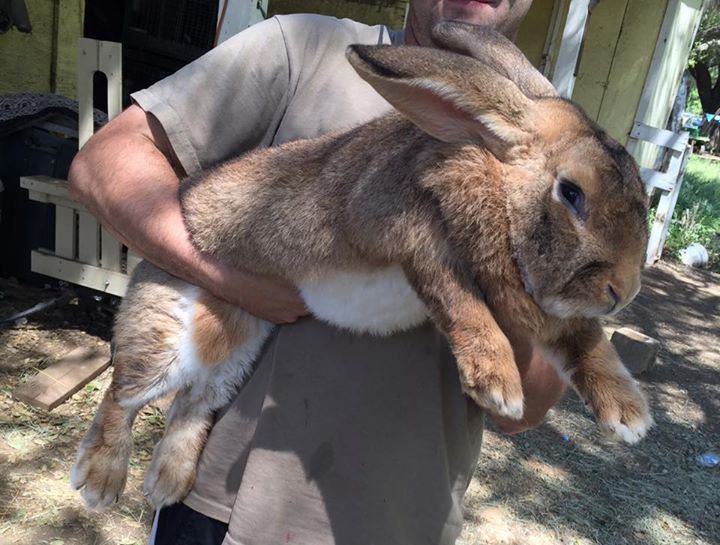Flemish Giant Life Expectancy: Everything You Need To Know
When it comes to rabbits, the Flemish Giant stands out like a skyscraper in a neighborhood of bungalows. These majestic creatures aren’t just large in size—they’re also huge in personality, history, and, yes, even their lifespan. If you’re considering bringing one of these gentle giants into your life, understanding their life expectancy is crucial. Let’s dive into the world of the Flemish Giant and uncover what makes them tick (and live).
Now, I get it—you’re probably wondering why life expectancy matters so much. Well, think about it: if you’re investing in a pet that could be around for years, you want to ensure you’re prepared for the journey. The Flemish Giant isn’t your average house rabbit; they require specific care, attention, and a whole lot of love. And, spoiler alert, their lifespan can vary depending on how well you take care of them.
But don’t worry, this isn’t all doom and gloom. With the right knowledge, tools, and dedication, you can help your Flemish Giant live a long, healthy, and happy life. So, buckle up because we’re about to break down everything you need to know about Flemish Giant life expectancy—and trust me, it’s going to be a ride!
Read also:Exploring The Influence Of Lays Peace Erome On Modern Society
Table of Contents:
- A Brief History of the Flemish Giant
- Flemish Giant Life Expectancy Overview
- Factors Affecting Lifespan
- The Role of Diet in Longevity
- Exercise and Mental Stimulation
- Healthcare and Preventive Measures
- Common Health Issues
- Creating the Ideal Environment
- Breeding and Its Impact
- Wrapping It Up
A Brief History of the Flemish Giant
The Flemish Giant is no ordinary rabbit. These rabbits have been around for centuries, with origins tracing back to Belgium. Historians believe they were first bred in the 16th century as a larger breed for meat and fur. Over time, their impressive size and docile nature made them a favorite among rabbit enthusiasts worldwide. Today, they’re known not just for their size but also for their friendly demeanor and striking appearance.
Here’s the kicker: their history plays a role in their life expectancy. Breeding practices over the years have influenced their genetic makeup, making them more resilient in some areas and more susceptible in others. Understanding their background helps us appreciate the nuances of their health needs.
Flemish Giant Life Expectancy Overview
So, let’s cut to the chase—how long do these big fellas live? On average, a Flemish Giant can live anywhere from 5 to 8 years. But wait, don’t let that number discourage you. With proper care, some have been known to live up to 10 years or even longer. Yes, you heard that right—longer!
What Does This Mean for You?
If you’re planning to adopt a Flemish Giant, you’re committing to at least half a decade of responsibility. It’s not just about providing food and shelter; it’s about creating a lifestyle that supports their well-being. Think of it like this: if you take care of your car with regular maintenance, it’ll last longer. The same goes for your furry friend.
Read also:Exploring Elon Musks Partners And Kids A Comprehensive Look
Factors Affecting Lifespan
Let’s get real for a sec—the lifespan of your Flemish Giant isn’t just a roll of the dice. Several factors come into play, and some are within your control. Here’s a quick rundown:
- Genetics: Some rabbits are just born with better genes. It’s the luck of the draw, but it’s something to consider when choosing a breeder.
- Diet: A balanced diet rich in hay, fresh vegetables, and quality pellets can work wonders for their health.
- Exercise: Just like humans, rabbits need to move. Regular exercise keeps their muscles strong and their hearts healthy.
- Healthcare: Regular vet check-ups and vaccinations can catch issues before they become serious.
- Environment: A clean, safe, and stimulating environment can make all the difference.
It’s like building a house—each factor is a brick. If you skimp on one, the whole structure could crumble. But if you pay attention to all of them, you’re setting the stage for a long and fulfilling life.
The Role of Diet in Longevity
Food is life, and for Flemish Giants, it’s no different. Their diet plays a massive role in their overall health and, consequently, their lifespan. Here’s what you need to know:
Hay—The Backbone of Their Diet
Hay isn’t just filler—it’s the primary source of fiber for rabbits. It aids in digestion, prevents dental issues, and keeps them full. Timothy hay is a popular choice, but you can mix it up with other types like orchard grass.
Pellets—The Protein Boost
Pellets provide essential nutrients, but they should be given in moderation. Too many pellets can lead to obesity, which shortens lifespan. Stick to high-quality pellets designed specifically for large breeds.
Fresh Veggies—The Secret Sauce
Leafy greens like kale, parsley, and dandelion greens are rabbit-approved superfoods. They’re packed with vitamins and minerals that support a healthy immune system. Just remember to introduce new veggies gradually to avoid digestive upset.
Exercise and Mental Stimulation
Let’s talk about playtime because, let’s be honest, who doesn’t love watching a rabbit hop around? Exercise isn’t just fun—it’s vital for their physical and mental health.
Why Exercise Matters
Rabbits are naturally active creatures. In the wild, they’d spend hours foraging and exploring. Domestic rabbits need that same level of activity to stay healthy. Without it, they’re prone to obesity, muscle weakness, and behavioral issues.
How to Keep Them Moving
Provide a spacious area for them to roam. Bunny-proof your home by covering electrical cords and securing fragile items. You can also invest in toys that encourage natural behaviors like digging and chewing.
Healthcare and Preventive Measures
No one likes a trip to the vet, but regular check-ups are non-negotiable for Flemish Giants. Here’s why:
- Vaccinations: Protect them from diseases like myxomatosis and rabbit hemorrhagic disease.
- Dental Care: Rabbits’ teeth grow continuously, so they need to wear them down with proper chewing materials.
- Parasite Control: Fleas, mites, and other parasites can wreak havoc on their health. Use preventive treatments as recommended by your vet.
Think of healthcare as an insurance policy. Sure, it costs money upfront, but it saves you from bigger bills—and heartache—down the road.
Common Health Issues
Even with the best care, Flemish Giants can face health challenges. Here are some common issues to watch out for:
Arthritis
Due to their size, Flemish Giants are prone to joint problems. Providing soft bedding and avoiding slippery surfaces can help reduce strain on their joints.
Gastrointestinal Stasis
This is a serious condition where the digestive system slows down or stops entirely. Symptoms include lack of appetite, lethargy, and absence of droppings. Immediate vet attention is crucial.
Obesity
Overfeeding or lack of exercise can lead to obesity, which puts extra stress on their organs and joints. Stick to a balanced diet and encourage activity.
Creating the Ideal Environment
Your Flemish Giant’s living space should be as close to their natural habitat as possible. Here’s how to create the perfect setup:
- Space: They need plenty of room to move around. A large pen or a designated room works well.
- Temperature: Rabbits are sensitive to extreme temperatures. Keep them in a cool, well-ventilated area during hot weather.
- Bedding: Soft, absorbent bedding like paper-based litter is ideal. Avoid cedar or pine shavings, as they can be harmful.
Remember, their environment isn’t just about comfort—it’s about safety. A secure, stress-free space can significantly impact their lifespan.
Breeding and Its Impact
Breeding is a double-edged sword. On one hand, it preserves the breed. On the other, it can lead to health issues if not done responsibly. Here’s what you need to know:
Responsible Breeding
Breeders should prioritize the health and well-being of the rabbits. This means avoiding inbreeding, ensuring proper nutrition, and providing adequate medical care.
Impact on Lifespan
Frequent breeding can take a toll on a doe’s body, potentially shortening her lifespan. If you’re considering breeding your Flemish Giant, consult a vet to ensure it’s safe for both the mother and the kits.
Wrapping It Up
So, there you have it—the lowdown on Flemish Giant life expectancy. While their lifespan averages around 5 to 8 years, with proper care, they can live even longer. Genetics, diet, exercise, healthcare, and environment all play a role in determining how long they’ll be part of your life.
Here’s the bottom line: if you’re ready to commit to the responsibility, a Flemish Giant can be an incredible companion. They’re intelligent, affectionate, and, let’s face it, downright adorable. So, whether you’re a seasoned rabbit owner or a first-timer, remember that every small action you take can make a big difference in their life.
Now, here’s where you come in. Got questions? Drop them in the comments below. Want to share your own experiences with Flemish Giants? We’d love to hear them. And if you found this article helpful, don’t forget to share it with your fellow rabbit lovers. Together, we can help these gentle giants live their best lives!


